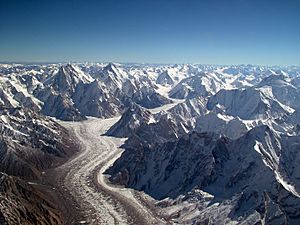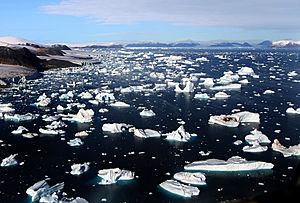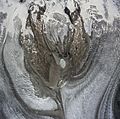Glacier facts for kids

A glacier is a large body of ice and snow. It forms because the snow in an area does not all melt in summer. Each winter, more snow is added. The weight of all the snow creates pressure. This pressure turns the lower parts of the snow into ice. After this happens for many years, the glacier will start growing large. It becomes so heavy that gravity causes the ice to move. It flows downwards like water but very slowly. A glacier only moves about 50 metres (160 ft) per year. New snowfalls replace the parts that flow away.
Glaciers are the largest sources fresh water on Earth. The largest bodies of salt water are the Oceans
Contents
Creation

Glaciers will only form in places that are cold enough and get enough snow over time. This can take a long time. It often takes tens or hundreds of years for a glacier to form. There are two kinds of glaciers: continental glaciers and alpine glaciers. Alpine glaciers are also called mountain glaciers.
- Continental glaciers are glaciers that spread out over a large area of land. They were created mostly during the Ice Ages a long time ago. There are still some continental glaciers in Greenland and Antarctica. They often flow downwards into the sea and break up. The broken parts that float in the sea are called icebergs.
- Alpine glaciers form in mountain areas. They are smaller than continental glaciers. Alpine glaciers usually flow until they reach a point where the temperature is warm enough that the ice melts completely during the summer.
Effects
Glaciers are very important. They have a large effect on the environment. They do this because they are very large and heavy. When they move, they erode mountains and land. Also, since they froze long ago, snow crystals and air bubbles inside are kept in good condition. These can provide a large amount of information for scientists. Recently glaciers have been melting more than they did in the past. Many scientists think this is happening because global warming is changing the climate.
Appearance
Glaciers are blue in color. This is because water is very good at absorbing light. Only the strongest light, with the most energy, is able to escape. Blue is the color of light that has the most energy. Because of this, blue is the only color of light that can escape without being absorbed. The thicker the glacier is, the more blue it appears.
Images for kids
-
The glacier of the Geikie Plateau in Greenland.
-
Aerial view of a glacier in Chugach State Park, Alaska, United States of America
-
Webber Glacier on Grant Land (northern Ellesmere Island) is an advancing polar glacier and frozen to the glacier bed. Debris rich layers of the ground moraine are sheared and folded into the ice. The steep icefront shows waterfalls. The glacier front is 6 km broad and up to 40 m high (July 20, 1978)
-
Shear or herring-bone crevasses on Emmons Glacier (Mount Rainier); such crevasses often form near the edge of a glacier where interactions with underlying or marginal rock impede flow. In this case, the impediment appears to be some distance from the near margin of the glacier.
-
Black ice glacier near Aconcagua, Argentina
-
Fox Glacier in New Zealand finishes near a rainforest.
-
Glacial moraines above Lake Louise, Alberta, Canada
-
South Cascade Glacier in Washington documented from 1928 to 2003 showing the recent rapid glacier retreating. By looking at this photo it's clear to see how quickly the glaciers are retreating in the modern world. This kind of retreating is the result of climate change which has significantly increased due to human impacts. This photo was taken from USGS U.S. Department of Interior research looking at the last 50 years of glacier change.
-
Northern polar ice cap on Mars.
-
Ice calving from the terminus of the Perito Moreno Glacier in western Patagonia, Argentina.
-
The Aletsch Glacier, the largest glacier of the Alps, in Switzerland.
-
The Quelccaya Ice Cap is the second-largest glaciated area in the tropics, in Peru.
-
Sightseeing boat in front of a tidewater glacier, Kenai Fjords National Park, Alaska.
-
A glacier cave located on the Perito Moreno Glacier in Argentina.
-
Crossing a crevasse on the Easton Glacier, Mount Baker, in the North Cascades, United States.
-
Glacier as seen by HiRISE under the HiWish program. Area in the rectangle is enlarged in the next photo. Zone of accumulation of snow at the top. Glacier is moving down valley, then spreading out on plain. Evidence for flow comes from the many lines on surface. Location is in Protonilus Mensae in Ismenius Lacus quadrangle.
See also
 In Spanish: Glaciar para niños
In Spanish: Glaciar para niños






























